
by Raul Lopez | Sep 3, 2024 | Uncategorized
In recent years, the conversation surrounding the use of psychedelic therapy for mental health disorders, particularly post-traumatic stress disorder (PTSD), has gained significant momentum. MDMA-assisted therapy for PTSD has been at the forefront of this discussion, with growing evidence supporting its potential as an effective treatment. However, the journey toward legalization is fraught with challenges, as demonstrated by the FDA’s recent rejection of the therapy. This article delves into the complexities of this issue, examining the current state of research, regulatory hurdles, and the societal perceptions that influence the likelihood of MDMA-assisted therapy becoming legal in the future.
The Therapeutic Potential of MDMA-Assisted Therapy
MDMA, commonly known as ecstasy, is a psychoactive drug that has long been associated with recreational use. However, in a controlled therapeutic setting, it has shown remarkable potential in treating PTSD, a debilitating mental health condition. PTSD is characterized by the persistent re-experiencing of traumatic memories, which can lead to severe anxiety, depression, and other mental health issues. Traditional treatments, such as behavioral therapy and medication, are often insufficient for many patients, leaving them in a constant state of distress.
Research led by organizations like the Multidisciplinary Association for Psychedelic Studies (MAPS) and its subsidiary, MAPS Public Benefit Corporation, has provided compelling evidence that MDMA, when used alongside psychotherapy, can lead to significant reductions in PTSD symptoms. The therapy protocol involves a series of therapy sessions, where trial participants take MDMA under the supervision of trained therapists. These sessions aim to create a safe space for patients to confront and process their traumatic memories, reducing the emotional intensity of these painful memories.
In clinical trials, many participants have described their experiences with MDMA-assisted therapy as transformative. The drug appears to enhance emotional processing, allowing patients to confront traumatic memories with reduced fear and anxiety. This, in turn, facilitates deeper and more effective therapeutic work. A study published in Nature Medicine highlighted that a significant portion of trial participants experienced a reduction in PTSD symptoms, with some no longer meeting the criteria for the disorder after just a few sessions. Given these promising results, why hasn’t the therapy been greenlit by regulatory bodies like the FDA?
The FDA’s Rejection: Understanding the Setback
The FDA’s recent rejection of MDMA-assisted therapy for PTSD has been a significant setback for advocates of psychedelic medicine. However, it’s important to understand that this does not necessarily spell the end for the therapy’s future prospects. The rejection was based on concerns related to the study’s methodology, patient selection criteria, and the long-term safety of MDMA use. The FDA emphasized the need for more rigorous and extensive research before it can consider approval.
Specifically, the FDA’s concerns focused on the potential for misuse of MDMA, the possibility of long-term adverse effects, and the need for more data on the sustainability of the therapy’s benefits. The agency also raised issues regarding the allegations of misconduct in some of the trials, which have cast a shadow over the research process. These concerns were discussed at an advisory committee meeting, where experts debated the scientific evidence presented by the researchers.
While this may seem like a roadblock, it can also be viewed as an opportunity for further refinement and validation of the therapy. The FDA’s feedback provides a clear roadmap for researchers to address the issues raised and strengthen their case. The rejection is not a blanket dismissal of MDMA-assisted therapy but rather a call for more robust evidence to ensure patient safety and treatment efficacy.
The history of psychoactive drugs in therapeutic contexts is filled with examples of initial skepticism giving way to acceptance as more data becomes available. The potential of psychedelics like MDMA in treating mental health conditions is still being explored, and the scientific community is far from reaching a consensus. However, as more research is conducted and the body of evidence grows, the case for the therapeutic potential of MDMA and other psychedelic drugs becomes increasingly difficult to ignore.
The Role of Advisory Committees and Regulatory Bodies
Advisory committees and regulatory bodies like the FDA play a crucial role in determining the future of psychedelic-assisted therapy. These committees are tasked with evaluating the safety and efficacy of new treatments, relying on scientific evidence and expert opinions to guide their decisions. In the case of MDMA-assisted therapy, the advisory committee’s feedback was instrumental in shaping the FDA’s decision.
The advisory committee meeting that reviewed the MDMA trials was marked by intense debate. On one hand, advocates for psychedelic medicine argued that the therapeutic potential of MDMA was too significant to ignore, especially for a condition as severe as PTSD. On the other hand, concerns about the long-term safety of the drug, the integrity of the research process, and the potential for abuse were raised by skeptics.
Despite the FDA’s rejection, the advisory committee acknowledged the need for continued research into MDMA-assisted therapy. The committee recommended that MAPS and other researchers conduct additional trials, with a focus on addressing the concerns raised. This recommendation is a positive sign that regulatory bodies are open to the idea of psychedelic therapy, provided that the necessary safeguards are in place.
The Path to Legalization: What Needs to Happen?
The road to legalization for MDMA-assisted therapy is likely to be a gradual one, influenced by several key factors:
- Ongoing Research and Clinical Trials: Continued clinical trials and studies will be crucial in addressing the FDA’s concerns. As more data is gathered on the long-term effects of MDMA and its efficacy in treating PTSD, the case for legalization will become stronger. Researchers will need to ensure that their studies are methodologically sound and free from allegations of misconduct.
- Regulatory Flexibility and Public Pressure: The FDA’s stance on psychedelic therapies may evolve over time, especially as public and political support for these treatments grows. The agency has shown a willingness to adapt its approach to emerging therapies, as seen in the case of other innovative treatments. Public perception and advocacy efforts will also play a significant role in shaping the regulatory landscape.
- Global Trends and Influences: The United States is not alone in exploring the therapeutic potential of psychedelics. Countries like Canada and Australia have already taken steps toward legalizing psychedelic-assisted therapies, including the use of magic mushrooms and MDMA. These global developments could influence the FDA’s decision-making process and accelerate the path to legalization.
- Educational Efforts and Societal Perception: Shifting societal attitudes toward psychedelics will play a significant role in the push for legalization. As the stigma surrounding MDMA and other psychoactive drugs diminishes and more people become aware of their potential benefits, there may be increased pressure on regulators to approve these therapies. Educational efforts by institutions like Johns Hopkins University, which has been at the forefront of psychedelic research, will be key in changing public perception.
- Addressing Safety Concerns: One of the primary hurdles to legalization is ensuring the safety of MDMA-assisted therapy. Researchers must demonstrate that the therapy protocol is safe, with manageable risks, and that the benefits outweigh any potential harm. This includes addressing concerns about the possibility of a “therapy cult” culture, where the use of MDMA could be misused or abused outside of a controlled therapeutic setting.
- Integration into Mainstream Medicine: For MDMA-assisted therapy to become a viable treatment option, it will need to be integrated into mainstream medical practices. This means training healthcare professionals in the safe and effective administration of the therapy, developing standardized protocols, and ensuring that the therapy is accessible to those who need it.
The Broader Implications for Psychedelic Medicine
The debate over MDMA-assisted therapy for PTSD is just one part of a larger conversation about the potential of psychedelics in mental health treatment. Psychedelic medicine, which includes the use of substances like magic mushrooms, LSD, and psilocybin, is gaining traction as a promising field of study. These substances have shown potential in treating a range of mental health conditions, from depression and anxiety to addiction and end-of-life distress.
Johns Hopkins University and other leading research institutions are conducting groundbreaking studies on the therapeutic potential of psychedelics. The results of these studies could pave the way for a new era in mental health treatment, where psychedelic-assisted therapy becomes a standard part of the therapeutic toolkit.
However, the path to widespread acceptance and legalization of psychedelic medicine will not be easy. The history of psychoactive drugs in society is complex, marked by periods of enthusiasm, backlash, and regulation. For MDMA-assisted therapy and other forms of psychedelic medicine to become legally accepted treatments, researchers, advocates, and regulators will need to work together to build a strong foundation of scientific evidence and public trust.
Conclusion: A Future Full of Possibilities
While the FDA’s recent rejection of MDMA-assisted therapy for PTSD may seem discouraging, it is by no means the final word on the matter. The future of this therapy depends on continued research, evolving regulatory perspectives, and changing public attitudes. As more evidence emerges and societal acceptance grows, the likelihood of MDMA-assisted therapy becoming legal in the United States increases. For now, the focus remains on conducting the rigorous studies needed to ensure that this promising treatment can one day become a reality for those suffering from PTSD and other mental health disorders.
The potential of psychedelics in therapy is vast, and the conversation around their use is just beginning. With the right approach, MDMA-assisted therapy could become a transformative treatment for PTSD, offering hope to millions of people worldwide. The journey toward legalization may be long and challenging, but the promise of a new frontier in mental health care is worth the effort.
Article 4
The Promising Role of Psychedelic Drugs in Treating Psychiatric Disorders
Psychedelic drugs, long stigmatized and relegated to the fringes of society, are now at the forefront of groundbreaking research aimed at addressing some of the most challenging mental health conditions. A recent study by researchers from the University of Southern Denmark and Imperial College London has brought to light the remarkable therapeutic potential of psychedelics in treating psychiatric disorders such as depression, anxiety, PTSD, and substance use disorders. This article delves into the study’s findings, explores the mechanisms behind the therapeutic effects of psychedelics, and considers the implications for the future of mental health treatment.
The Renaissance of Psychedelic Research
The revival of interest in psychedelic research marks a significant shift in how mental health professionals approach treatment-resistant conditions. Treatment-resistant depression, for instance, has long posed a challenge to clinicians, with many patients finding little relief from traditional treatments such as antidepressants and behavioral therapy. Psychedelic drugs, including psilocybin (found in magic mushrooms), LSD, and MDMA, are now being studied for their potential to offer relief where conventional treatments have failed.
The study published in May 2024, conducted by a team of researchers from the University of Southern Denmark and Imperial College London, adds to the growing body of evidence supporting the use of psychedelics in treating mental disorders. This research focuses on understanding how classic psychedelics interact with the brain and how these interactions can alleviate symptoms of psychiatric conditions such as depressive disorder, anxiety, and post-traumatic stress disorder (PTSD). The findings suggest that psychedelic treatment could represent a paradigm shift in how we approach mental health care.
How Psychedelics Work: The Science Behind the Experience
One of the key findings of the study is that psychedelic drugs exert their effects by promoting neuroplasticity— the brain’s ability to reorganize itself by forming new neural connections. This is particularly important in the context of mental illness, where rigid patterns of brain activity can contribute to the persistence of symptoms. The study highlights that psychedelics, including psilocybin, can stimulate the growth of dendritic spines, small protrusions on neurons that are crucial for cell-to-cell communication. This enhanced communication can lead to a reduction in symptoms by allowing the brain to ‘reset’ its default mode of functioning.
The study also explores how psychedelics affect the brain’s default mode network (DMN), a group of interconnected brain regions that are active when the mind is at rest and not focused on the outside world. Overactivity in the DMN is often associated with rumination, a hallmark of depression and anxiety. By reducing DMN activity, psychedelics can help patients break free from negative thought patterns, offering a potential breakthrough therapy for conditions like treatment-resistant depression.
Moreover, the study delves into the role of mystical-type experiences induced by psychedelics. These experiences, characterized by a profound sense of unity, transcendence, and connection, are thought to contribute to the therapeutic effects of psychedelics. Patients often describe these experiences as deeply meaningful, leading to lasting changes in perspective and behavior. The researchers note that these mystical experiences are not merely side effects but may be integral to the therapeutic process, helping patients to reframe their understanding of their mental illness.
The Therapeutic Potential of Psychedelic-Assisted Therapy
The therapeutic potential of psychedelic-assisted therapy is vast, and the study identifies several key areas where these drugs could have a significant impact. Depression, anxiety, PTSD, and substance use disorders are among the conditions that could benefit from this approach, particularly in cases where patients have not responded to traditional treatments.
- Treatment-Resistant Depression: The study reinforces previous findings that psychedelics can lead to rapid and sustained reductions in depressive symptoms, even in cases of treatment-resistant depression. Patients who have undergone psilocybin-assisted therapy often report a profound sense of relief from the burdens of depression, sometimes after just a single dose of psilocybin. The study suggests that this rapid response could be due to the drug’s ability to disrupt rigid patterns of brain activity and promote neuroplasticity.
- Anxiety and PTSD: For patients with anxiety disorders and PTSD, particularly those related to trauma or terminal illness, psychedelic-assisted therapy has shown promise in reducing symptoms and improving quality of life. The study notes that MDMA-assisted therapy, in particular, has been effective in helping patients process traumatic memories in a controlled therapeutic setting. This approach, known as MDMA-assisted psychotherapy, has been associated with significant improvements in PTSD symptoms, offering hope to those who have struggled with conventional treatments.
- Substance Use Disorders: Psychedelics are also being explored as potential treatments for substance use disorders, including alcohol use disorder and compulsive disorder. The study highlights that these substances can help disrupt the compulsive behaviors associated with addiction, offering a new avenue for treatment where traditional methods have failed. By promoting new ways of thinking and fostering a sense of connection, psychedelics may offer a path to recovery for those struggling with addiction.
- Suicidal Ideation: The study also explores the potential of psychedelics in addressing suicidal ideation, a common symptom of severe depression and other mental health disorders. While the research is still in its early stages, the findings suggest that psychedelic-assisted therapy could provide a rapid and effective treatment for those experiencing suicidal thoughts. This is particularly important given the limitations of current treatments, which often take weeks to become effective.
Addressing the Challenges: Safety and Regulation
Despite the promising results, the study also acknowledges the challenges that lie ahead in bringing psychedelic therapies into mainstream psychiatric practice. The legal status of many of these substances remains a significant barrier, as they are classified as Schedule I drugs in many countries, meaning they are considered to have no accepted medical use and a high potential for abuse.
Additionally, there is a need for further research to fully understand the long-term effects of psychedelic use, particularly in a therapeutic context. While the short-term benefits are becoming increasingly clear, the potential risks associated with repeated use, as well as the impact on vulnerable populations, must be thoroughly investigated. The study emphasizes the importance of monitoring for adverse effects and adverse events during clinical trials, particularly in patients with a history of mental illness.
The study also highlights the importance of set and setting— the psychological, social, and environmental factors that influence the psychedelic experience. Ensuring that patients receive these treatments in a safe and supportive environment is crucial for maximizing the therapeutic benefits and minimizing potential harms. The researchers stress that psychedelic-assisted therapy should only be conducted under the supervision of trained professionals, with careful attention to the dose of psilocybin or other psychedelics used in each session.
The Role of Regulatory Bodies and Advisory Committees
Regulatory bodies and advisory committees play a crucial role in determining the future of psychedelic-assisted therapy. These committees are tasked with evaluating the safety and efficacy of new treatments, relying on scientific evidence and expert opinions to guide their decisions. In the case of psychedelic treatment, the involvement of organizations like the Multidisciplinary Association for Psychedelic Studies (MAPS) has been instrumental in advancing the field.
The study notes that MDMA-assisted psychotherapy for PTSD has been granted “breakthrough therapy” designation by the FDA, a status that could expedite its approval process. However, the researchers also acknowledge that significant hurdles remain, particularly in addressing concerns about the long-term safety and potential for misuse of these substances.
The advisory committee meetings that review psychedelic research are often marked by intense debate. On one hand, advocates argue that the therapeutic potential of these substances is too significant to ignore, especially for conditions like treatment-resistant depression and PTSD. On the other hand, concerns about adverse effects, including the potential for suicidal ideation and the impact on vulnerable populations, are raised by skeptics.
The Broader Implications for Mental Health Treatment
The study conducted by the University of Southern Denmark and Imperial College London represents a significant step forward in our understanding of the therapeutic potential of psychedelics. As our knowledge of these substances deepens, the possibility of integrating psychedelic-assisted therapy into mainstream mental health treatment becomes more tangible.
The researchers suggest that psychedelics could play a crucial role in addressing the global mental health crisis, offering new hope to millions of people suffering from conditions like depression, anxiety, PTSD, and substance use disorders. However, realizing this potential will require a concerted effort from researchers, clinicians, and policymakers to navigate the legal, ethical, and scientific challenges that remain.
One of the most promising aspects of psychedelic-assisted therapy is its potential to provide rapid and sustained relief from symptoms, even in cases of treatment-resistant depression. This could represent a significant advancement in the field of mental health, where many treatments take weeks or months to become effective.
Additionally, the study highlights the importance of continuing research into the therapeutic use of classic psychedelics, including psilocybin, LSD, and MDMA. These substances, once dismissed as dangerous and without medical value, are now being reevaluated as powerful tools for healing. The study emphasizes that further research is needed to fully understand the mechanisms behind their effects and to develop safe and effective protocols for their use.
Conclusion: A New Era in Psychiatric Care
The research conducted by the University of Southern Denmark and Imperial College London represents a significant step forward in our understanding of the therapeutic potential of psychedelics. As our knowledge of these substances deepens, the possibility of integrating psychedelic-assisted therapy into mainstream mental health treatment becomes more tangible.
However, realizing this potential will require a concerted effort from researchers, clinicians, and policymakers to navigate the legal, ethical, and scientific challenges that remain. With ongoing studies and increasing public interest, the future of psychedelic medicine looks promising, offering hope to millions of people suffering from psychiatric disorders.
As this field of research continues to evolve, it is clear that psychedelic drugs may hold the key to unlocking new, more effective treatments for some of the most challenging mental health conditions. The journey is far from over, but the progress made thus far suggests that we are on the cusp of a newera in psychiatric care.
Credit: This article is based on research findings from the University of Southern Denmark and Imperial College London, as reported by ScienceDaily on May 23, 2024. The original publication can be found here.

by Raul Lopez | Jun 16, 2024 | Uncategorized
Introduction
In recent years, there has been a resurgence of interest in the therapeutic benefits of psychedelics. These substances, once vilified and misunderstood, are now being explored for their potential to treat various mental health conditions, including substance use disorders. A growing body of research suggests that psychedelic experiences can lead to significant reductions in the use of substances such as alcohol, tobacco, and other drugs. This comprehensive article explores the findings of recent studies on the impact of psychedelics on substance use, the mechanisms behind these effects, and the implications for future treatment approaches.
The Study: Overview and Findings
Study Overview
A pivotal study conducted by researchers from Johns Hopkins University investigated the impact of psychedelic experiences on substance use. This longitudinal study tracked participants who had undergone a psychedelic experience over a significant period. The participants included individuals who had used various psychedelics, such as psilocybin mushrooms, LSD (lysergic acid diethylamide), and ayahuasca, in both clinical and naturalistic settings.
Key Findings
The study found that a substantial number of participants reported reductions in their use of substances following their psychedelic experiences. Key findings included:
- Reduction in Alcohol Use: Many participants reported a significant decrease in alcohol consumption. Some individuals who had struggled with alcohol dependence achieved sobriety after their psychedelic experiences.
- Decrease in Tobacco Use: Participants also reported reductions in tobacco use. Some heavy smokers quit smoking altogether, while others significantly cut back on their cigarette consumption.
- Reduction in Other Drug Use: The study found that the use of other substances, such as opioids and stimulants, also decreased among participants. These reductions were often accompanied by improvements in mental health and overall well-being.
Mechanisms Behind Substance Use Reduction
Psychological Insights
One of the primary mechanisms through which psychedelics appear to reduce substance use is through profound psychological insights and shifts in perspective they can induce. During a psychedelic experience, individuals often gain new insights into their behaviors, motivations, and underlying issues that contribute to substance use. This heightened self-awareness can lead to a reevaluation of harmful behaviors and a renewed commitment to change.
- Mystical and Spiritual Experiences: Many participants reported having mystical or spiritual experiences during their psychedelic sessions. These experiences often led to a sense of interconnectedness, a deeper understanding of their place in the world, and a realization of the harm caused by their substance use. This can create a strong motivation to change and pursue healthier behaviors.
- Emotional Processing: Psychedelics can facilitate the processing of unresolved emotions and traumas that may be driving substance use. By addressing these underlying issues, individuals can find new ways to cope without relying on substances.

Neurobiological Effects
Psychedelics also have significant neurobiological effects that can contribute to their therapeutic potential. These substances interact with serotonin receptors in the brain, particularly the 5-HT2A receptor, which plays a key role in mood regulation, cognition, and perception.
- Neuroplasticity: Research has shown that psychedelics can promote neuroplasticity, the brain’s ability to form new neural connections. This can help individuals break free from entrenched patterns of thinking and behavior associated with substance use.
- Default Mode Network (DMN): Psychedelics temporarily disrupt the activity of the default mode network, a brain network associated with self-referential thinking and the maintenance of the ego. This disruption can lead to a reduction in the rigid patterns of thought that often underlie addiction.
Psychedelic-Assisted Therapy
Integration Sessions
Following a psychedelic experience, integration sessions with a therapist can help individuals make sense of their experiences, process any insights gained, and develop strategies for maintaining their progress.
- Therapeutic Integration: These sessions are crucial for helping individuals integrate their psychedelic experiences into their daily lives. Therapists trained in psychedelic integration can guide patients through understanding and applying their insights.
- Supportive Environment: Providing a safe and supportive environment for psychedelic experiences is crucial. This includes careful preparation, guidance during the session, and ongoing support afterward.
Broader Applications
The potential benefits of psychedelics for reducing substance use extend beyond clinical settings. Naturalistic use of psychedelics in safe and supportive environments, such as psychedelic retreats or guided ceremonies, can also lead to significant reductions in substance use.
- Community Support: Building a supportive community around psychedelic use can enhance its therapeutic effects. Sharing experiences and providing mutual support can help individuals maintain their commitment to change.
- Educational Programs: Educating individuals about the safe and responsible use of psychedelics, as well as their potential risks and benefits, can empower people to make informed decisions about their substance use.
Therapeutic Potential and Future Studies
Psychedelic-Assisted Therapy for Various Conditions
Psychedelic-assisted therapy is being explored for a range of mental health conditions, including treatment-resistant depression, anxiety disorders, and post-traumatic stress disorder (PTSD). The therapeutic potential of psychedelics is vast, and ongoing research continues to uncover new applications and benefits.
- Treatment-Resistant Depression: Studies have shown that psychedelics, particularly psilocybin, can be effective in treating depression that has not responded to traditional therapies. This has opened new avenues for treatment options for those with chronic mental health conditions.
- PTSD: Psychedelics are being studied for their potential to alleviate symptoms of PTSD. The ability of these substances to facilitate emotional processing and reduce fear responses makes them promising candidates for PTSD treatment.
Mechanisms of Action
Understanding the mechanisms through which psychedelics exert their effects is crucial for developing effective treatments. Research is focusing on several key areas:
- Serotonin Receptors: Psychedelics primarily act on serotonin receptors, particularly the 5-HT2A receptor. This interaction leads to the profound changes in perception, mood, and cognition experienced during a psychedelic trip.
- Neuroplasticity and Brain Connectivity: Psychedelics promote neuroplasticity and increase connectivity between different brain regions. This can help disrupt maladaptive patterns of thinking and behavior and promote mental flexibility.
- Default Mode Network: The temporary disruption of the default mode network by psychedelics can lead to a reduction in self-referential thinking and ego dissolution. This can help individuals gain new perspectives on their lives and behaviors.
Safety and Ethical Considerations
Safety in Psychedelic Use
Ensuring the safety of individuals using psychedelics is paramount. This involves careful screening, preparation, and monitoring during and after the psychedelic experience.
- Screening: Individuals should be screened for any contraindications, such as a history of psychosis or certain medical conditions, that may increase the risk of adverse reactions.
- Set and Setting: Creating a safe and supportive environment (set and setting) is crucial for minimizing risks and maximizing the therapeutic potential of psychedelics.
- Monitoring: Continuous monitoring during the psychedelic experience can help manage any challenging or adverse reactions that may occur.
Ethical Considerations
The ethical use of psychedelics involves ensuring informed consent, respecting individual autonomy, and promoting equitable access to treatments.
- Informed Consent: Participants should be fully informed about the potential risks and benefits of psychedelic use and provide voluntary consent before participating in any study or therapeutic session.
- Autonomy and Respect: Individuals should be treated with respect and their autonomy should be honored throughout the psychedelic experience and integration process.
- Equitable Access: Efforts should be made to ensure that psychedelic treatments are accessible to all individuals who could benefit, regardless of socioeconomic status or background.
Conclusion
The study’s findings highlight the potential of psychedelics to reduce substance use and promote long-term recovery. By facilitating profound psychological insights, emotional processing, and neurobiological changes, psychedelics offer a unique and powerful tool for addressing substance use disorders. As research continues to expand, psychedelic-assisted therapy could become an integral part of the treatment landscape, offering hope and healing to many individuals struggling with addiction.
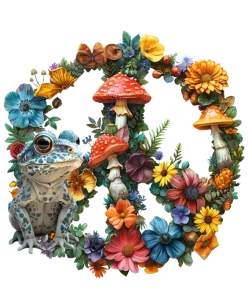
by Raul Lopez | Apr 30, 2024 | Uncategorized
Introduction: Psilocybin, the psychoactive compound found in magic mushrooms, has been captivating the attention of scientists, researchers, and curious minds for decades. As the interest in psychedelic substances grows, so does our understanding of their effects on the brain. In this article, we will delve into the current scientific knowledge about psilocybin’s actions in the brain, exploring its neurochemical interactions, brain regions affected, and the potential implications for mental health and well-being. Let’s embark on a journey of scientific exploration to uncover the mysteries of psilocybin and its effects on the most complex organ in our bodies – the brain.
I. The Neurochemistry of Psilocybin : Unlocking the 5-HT2A Receptors
Psilocybin’s primary mechanism of action revolves around its interactions with the serotonergic system in the brain. Specifically, it binds to the 5-HT2A receptors, which are part of the serotonin system. Serotonin is a neurotransmitter involved in mood regulation, cognition, and various physiological processes.
When psilocybin enters the brain, it is converted into its active form, psilocin. Psilocin then acts as a partial agonist at the 5-HT2A receptors, leading to increased serotonin activity. This heightened serotonin signaling is thought to play a crucial role in the psychedelic effects of psilocybin, including altered perceptions, mood shifts, and changes in consciousness.
B. Serotonin and Mood Regulation: The Role of 5-HT2A Receptors
The 5-HT2A receptors are widely distributed throughout the brain, with particularly high concentrations in regions like the prefrontal cortex, the thalamus, and the hippocampus. Activation of these receptors by psilocybin leads to an increased release of serotonin in these brain regions, resulting in alterations in sensory perception, emotional processing, and cognitive functions.
In the prefrontal cortex, which plays a central role in decision-making and emotional regulation, psilocybin’s influence on 5-HT2A receptors may contribute to the enhanced introspection and altered sense of self experienced during a psychedelic journey. The hippocampus, involved in memory formation and emotional regulation, is also affected, potentially contributing to the emotionally charged and vivid memories often reported after a psilocybin experience.

II. Altered Brain Connectivity and Functional Networks . The Default Mode Network
One of the most significant effects of psilocybin on the brain is the disruption of the default mode network (DMN). The DMN is a network of brain regions associated with self-referential thinking, introspection, and mind-wandering. When the DMN is highly active, it can contribute to rumination and repetitive thought patterns often observed in conditions like depression and anxiety.
Under the influence of psilocybin, the DMN’s activity is suppressed, leading to a breakdown of rigid thought patterns and increased brain connectivity between regions that do not usually communicate with each other. This “entropic” brain state is thought to underlie the profound shifts in consciousness and ego dissolution experienced during a psychedelic journey.
B. The Salience Network: Integrating Information
In addition to modulating the DMN, psilocybin also influences the salience network. The salience network is responsible for determining the importance of various stimuli and experiences, helping the brain decide what to pay attention to and what to ignore.
By altering the activity of the salience network, psilocybin may lead to increased sensitivity to sensory stimuli and a heightened sense of novelty. This can result in the intensification of colors, sounds, and emotions during a psychedelic experience, as well as a sense of connectedness to the environment and other people.
III. Neuroplasticity: Rewiring the Brain
Emerging research suggests that psilocybin may enhance neuroplasticity, the brain’s ability to reorganize and form new connections between neurons. This is significant because neuroplasticity is a fundamental aspect of learning, memory, and adaptation to new experiences.
By promoting synaptic plasticity, psilocybin could potentially help individuals break free from ingrained thought patterns, making it a promising therapeutic candidate for conditions where maladaptive behaviors or thought processes are a central feature.
B. Hippocampal Neurogenesis: A Spark of New Brain Cells
Recent studies have also suggested that psilocybin may stimulate hippocampal neurogenesis, the formation of new neurons in the hippocampus. This is a particularly exciting finding, as impaired neurogenesis in the hippocampus has been associated with mood disorders and cognitive decline.
The potential of psilocybin to enhance neurogenesis raises intriguing possibilities for its therapeutic applications, especially in conditions like depression, where promoting the growth of new neurons could contribute to improved mood and cognitive functioning.
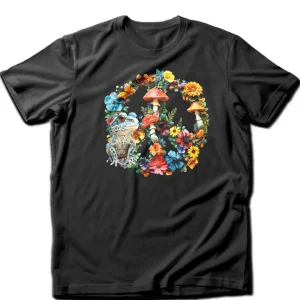
IV. Addressing Depression and Anxiety: Potential Therapeutic Applications
Studies have shown that psilocybin-assisted therapy may be effective in treating depression and anxiety in certain individuals. During a guided therapeutic session, the altered state of consciousness induced by psilocybin may provide a window of opportunity for patients to gain insights into their mental health challenges and explore potential solutions.
The temporary dissolution of the self and the altered perceptions experienced during a psilocybin session can lead to a sense of interconnectedness, increased empathy, and emotional breakthroughs. This can be particularly impactful for individuals struggling with existential distress or a lack of meaning in their lives.
B. Addiction Treatment: Breaking the Cycle
Another area of research interest is psilocybin’s potential in treating addiction. Studies have shown that psilocybin-assisted therapy can help individuals with substance use disorders gain new perspectives on their behaviors and motivations. This increased insight, coupled with the heightened motivation for change experienced during the psychedelic experience, may aid in breaking the cycle of addiction and facilitating long-term recovery.
C. Post-Traumatic Stress Disorder (PTSD) Treatment: Healing Trauma
Research into the use of psilocybin for treating PTSD has shown promising results. Psilocybin’s ability to disrupt maladaptive thought patterns and enhance emotional processing may offer a unique approach to healing trauma. In a therapeutic setting, patients can confront and process traumatic memories with a heightened sense of safety and support.
V. Set and Setting: The Importance of Context
While psilocybin shows promise as a therapeutic tool, it is essential to approach its use with caution and respect. The psychological state of the user (set) and the physical and social environment (setting) in which the experience occurs can significantly influence the outcomes of a psilocybin session.
Proper screening, preparation, and guidance by trained professionals are crucial to ensuring a safe and beneficial experience. Individuals with a personal or family history of psychiatric conditions or those on certain medications should approach psilocybin use with particular care.
B. Potential Risks: Addressing Adverse Effects
While psilocybin is generally considered safe when used responsibly and in controlled settings, there are potential risks associated with its use. Acute effects may include anxiety, confusion, and sensory distortions. In rare cases, individuals may experience a “bad trip,” characterized by overwhelming fear or paranoia.
Additionally, the long-term effects of regular psilocybin use are not
yet fully understood. More research is needed to assess potential risks related to frequent or high-dose use.
C. Personal and Cultural Factors: Individual Differences in Response
It is essential to acknowledge that individual responses to psilocybin can vary widely. Factors such as genetics, personality traits, previous experiences with psychedelics, and cultural background can influence how individuals react to psilocybin.
Furthermore, the context in which psilocybin is used plays a crucial role. In traditional cultural settings, where psychedelics have been used for centuries as part of religious or healing rituals, the experience is often guided and integrated into a larger cultural framework. In contrast, contemporary recreational use without proper guidance and preparation may lead to less favorable outcomes.
VI. Expanding Knowledge: Ongoing Studies and Clinical Trials
The resurgence of interest in psychedelic research has paved the way for numerous ongoing studies and clinical trials exploring the therapeutic potential of psilocybin. These studies aim to investigate psilocybin’s effects on various mental health conditions, its underlying mechanisms of action, and potential long-term benefits.
Additionally, the legality of psilocybin and other psychedelics has gradually evolved, allowing for more research opportunities. Organizations like the Multidisciplinary Association for Psychedelic Studies (MAPS) and the Usona Institute have played instrumental roles in advancing research and advocating for the responsible use of psychedelics.
B. FDA Approval and Regulatory Pathways
The promising results from clinical trials are sparking interest from regulatory agencies such as the U.S. Food and Drug Administration (FDA). In 2020, the FDA granted “breakthrough therapy” designation to psilocybin-assisted therapy for treatment-resistant depression, fast-tracking the drug development process. If the clinical trials continue to show positive outcomes, psilocybin could receive FDA approval for specific therapeutic uses in the coming years.
C. Integration into Mainstream Mental Health Care
The successful integration of psilocybin into mainstream mental health care would require a delicate balance between scientific rigor and accessibility. Ensuring that patients have access to trained professionals, comprehensive screening procedures, and appropriate therapeutic support will be critical to harnessing psilocybin’s therapeutic potential safely and effectively.
In conclusion, the impact of psilocybin on the brain is a multifaceted and fascinating subject. From its neurochemical interactions with the serotonergic system to its profound effects on brain connectivity and neuroplasticity, psilocybin opens doors to novel therapeutic possibilities.
As scientific research progresses and our understanding of psilocybin deepens, we must approach its use with care and respect for its potential benefits and risks. Responsible, evidence-based approaches are crucial to ensuring the safe integration of psilocybin into mental health care.
As psilocybin research continues to expand, it holds the promise of revolutionizing mental health treatment by offering new insights into consciousness, healing, and the human brain’s remarkable potential for growth and change. With a commitment to ethical exploration and compassionate care, we can embrace the transformative power of psilocybin while maintaining a focus on safety, education, and the well-being of individuals seeking its therapeutic benefits.
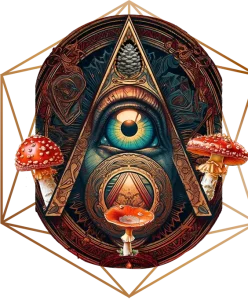
by Raul Lopez | Aug 18, 2023 | Uncategorized
In recent years, the practice of microdosing psychedelics has ignited discussions about its potential to alleviate depressive symptoms. Advocates of microdosing suggest that consuming sub-perceptual doses of psychedelic substances, such as LSD or mushrooms, may hold promise in addressing depression. However, the question of whether microdosing can cure depression remains a complex and nuanced one, requiring a comprehensive examination of scientific research, anecdotal evidence, and ethical considerations.
Microdosing and Depression: Seeking Relief from the Shadows
Depression, a widespread mental health condition, impacts millions of individuals worldwide. Those who experience depression often seek various treatment options to alleviate their symptoms and improve their overall well-being. The potential for microdosing to offer relief from depressive symptoms has intrigued both researchers and individuals struggling with this condition.
Anecdotal reports from individuals who have engaged in microdosing suggest a range of positive outcomes. Some report experiencing improved mood, increased emotional resilience, and a renewed sense of connection to life. These subjective accounts have sparked curiosity about the potential therapeutic benefits of microdosing, particularly for individuals who have not responded well to traditional treatments.

The Intersection of Science and Experience
While anecdotal reports provide insight into potential benefits, it’s essential to consider scientific research to understand the potential of microdosing in treating depression. Preliminary studies have shown promising results, with some participants reporting reductions in depressive symptoms after engaging in microdosing protocols. However, these studies are limited in scope and often lack rigorous experimental designs, making it challenging to draw definitive conclusions.
The potential mechanisms through which microdosing might influence depression are multifaceted. Some researchers hypothesize that the interaction between psychedelic substances and serotonin receptors in the brain could play a role in mood regulation. Others suggest that the altered states of consciousness induced by microdosing may lead to shifts in perspective and increased emotional resilience.
Clinical Trials and Therapeutic Potential
The exploration of microdosing’s therapeutic potential involves clinical trials that examine its effects on depression. Researchers from institutions such as Johns Hopkins University have embarked on studies that delve into the interaction between microdosing and brain activity. These studies aim to unravel the effects of single doses of psilocybin, the active ingredient in psychedelic mushrooms, on treatment-resistant depression and severe depressive disorder.
Previous studies involving larger doses of psilocybin have shown promising results in treating depression and other affective disorders. Psilocybin-assisted therapy, conducted in a controlled environment with the guidance of medical professionals, has shown therapeutic effects on emotional empathy, cognitive functioning, and improvements in mood. While these findings are compelling, the translation of such effects to microdosing remains an ongoing subject of investigation.
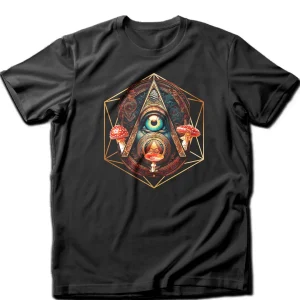
Balancing Therapeutic Benefits and Risks
As the discourse around microdosing for depression continues, it’s essential to consider potential risks alongside therapeutic benefits. The potential for abuse, adverse events, and the lack of standardized dosing are factors that demand careful consideration. Adverse effects such as changes in blood pressure, altered cognitive performance, and even hallucinogenic experiences have been reported in some microdosing studies.
Researchers are also exploring the impact of microdosing on cognitive functions and symptoms of anxiety. The potential interactions with serotonergic psychedelics, such as lysergic acid diethylamide (LSD), further complicate the picture. As the therapeutic process of microdosing unfolds, it’s crucial to conduct follow-up studies with large sample sizes to provide comprehensive insights into its effects.
The Road Ahead: Toward a Comprehensive Understanding
In conclusion, the question of whether microdosing can cure depression encompasses a myriad of factors, from individual experiences to scientific research and ethical considerations. While there is growing interest in the potential therapeutic effects of microdosing, it’s vital to approach this topic with a balanced and evidence-based perspective. The intricate interplay between the effects of microdosing, brain activity, and symptoms of depression necessitates rigorous research, interdisciplinary collaboration, and ongoing dialogue.
The journey toward understanding the potential of microdosing in treating depression is marked by complexities and uncertainties. As researchers, mental health professionals, and individuals seeking relief continue to explore this terrain, the broader implications of microdosing for mental health, cognitive functioning, and emotional well-being remain subjects of discovery and inquiry.
Disclaimer: This article provides an exploration of the potential relationship between microdosing and depression. It does not endorse or encourage the use of illegal substances. Individuals seeking treatment for depression should consult medical professionals and explore evidence-based treatments.

by Raul Lopez | Aug 8, 2023 | Uncategorized
Introduction: Magic mushrooms, renowned for their psychedelic effects and diverse range of species, have fascinated humans for centuries. Among the many questions that arise about these intriguing fungi, one stands out: Are magic mushrooms blue? In this article, we will delve into the science behind the elusive blue hue often associated with certain magic mushroom species, exploring the factors contributing to this phenomenon and its significance in the world of psychedelics.
I. The World of Magic Mushrooms: Diversity and Mystery A. The Allure of Psilocybin-Containing Mushrooms
Magic mushrooms, scientifically classified as Psilocybe species, contain the psychoactive compounds psilocybin and psilocin. These compounds induce altered states of consciousness, profound insights, and visual distortions.
B. The Quest for Identification
Identifying magic mushrooms involves observing various characteristics, including color, shape, size, gill structure, and spore print. These features are crucial for accurate species identification and understanding their potential effects.
II. The Mystery of Blue Magic Mushrooms A. Species with Blue Hues
Certain magic mushroom species, particularly Psilocybe cubensis varieties like “Blue Meanies,” are associated with a blue or bluish hue. This unique coloration often appears on different parts of the mushroom, including the cap, stem, and mycelium.
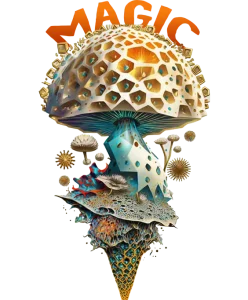
B. Factors Contributing to the Blue Color
- Psilocin Oxidation
The blue coloration in magic mushrooms is attributed to the oxidation of psilocin, one of the main active compounds. When psilocin comes into contact with oxygen or light, it undergoes chemical changes that lead to the formation of blue pigments.
- Structural Properties
The microscopic structures within the mushroom’s cells can also contribute to the perception of blue color. This phenomenon, known as structural coloration, results from the interaction of light with these cellular structures.
III. The Influence of Environment and Genetics A. Genetic Variability
Genetics play a significant role in determining the coloration of magic mushrooms. Different species have distinct genetic traits that contribute to their color and appearance.
B. Environmental Factors
Environmental conditions, such as humidity, light exposure, temperature, and substrate composition, can influence the intensity of the blue coloration in magic mushrooms. However, the extent to which environmental factors affect coloration varies among species.
IV. The Significance of Blue Magic Mushrooms A. Identification and Recognition
The blue coloration in magic mushrooms can aid in species identification, particularly for those familiar with the characteristic color patterns of different Psilocybe species.
B. Cultural and Folklore Significance
The blue hue of certain magic mushrooms has contributed to their cultural significance and associations with mystical experiences. In some cultures, blue-colored mushrooms have been revered for their purported spiritual and shamanic properties.
V. Variability and Uniqueness Among Species A. Not All Magic Mushrooms Are Blue
While some species of magic mushrooms exhibit a blue hue, it is essential to note that not all magic mushrooms display this coloration. Variability in color exists among species, and other factors, such as genetics and environment, can influence color expression.
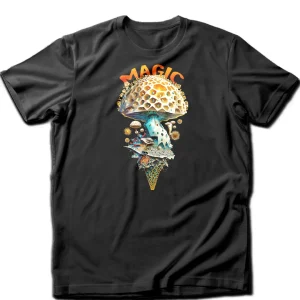
B. Appreciating the Diversity
The diverse array of colors found in magic mushrooms adds to their allure and mystique. Each species possesses distinct attributes that contribute to their overall appearance and unique visual appeal.
VI. Conclusion The question of whether magic mushrooms are blue is an intriguing one that highlights the complex interplay of genetics, environment, and chemical reactions within these remarkable fungi. While certain Psilocybe species, such as “Blue Meanies,” exhibit a distinct blue coloration, the phenomenon is not universal among all magic mushroom species.
Understanding the factors contributing to the blue coloration in magic mushrooms enhances our appreciation of their biodiversity and the intricate mechanisms at play in their growth. This knowledge also underscores the importance of accurate species identification for both scientific research and safe recreational use.
As research on magic mushrooms continues and our understanding of their properties deepens, the enigma of the blue magic mushroom adds to the allure of these fungi and invites us to explore the intricate beauty of the natural world.

by Raul Lopez | Aug 6, 2023 | Uncategorized
Introduction: The Bufo Alvarius, commonly known as the Colorado River toad or Sonoran Desert toad, has gained significant attention for the potent psychoactive compound it secretes, 5-Methoxy-N,N-Dimethyltryptamine (5-MeO-DMT). Many people are curious about the possibility of keeping these unique amphibians as pets. However, before considering ownership of a Bufo Alvarius, it is essential to understand the legal and ethical implications involved. In this article, we will explore whether it is legal to own a Bufo Alvarius as a pet, the challenges associated with keeping them, and the responsible considerations for those interested in these remarkable creatures.
I. Legal Status of Bufo Alvarius Ownership A. Protected Species
The Bufo Alvarius toad is a protected species in many regions of its natural habitat, including the southwestern United States and northern Mexico. Due to the decline in wild populations and concerns about habitat destruction, governments have implemented laws and regulations to safeguard these toads from exploitation and harm.
B. Legal Restrictions
In many areas, it is illegal to capture, possess, or sell Bufo Alvarius toads. Additionally, the extraction of their secretions, which contain 5-MeO-DMT, may also be prohibited or strictly regulated under controlled substances laws.

II. Challenges of Owning Bufo Alvarius as Pets A. Specialized Care Requirements
Bufo Alvarius toads have specific care requirements that may be challenging for inexperienced keepers. They are native to arid environments and need carefully controlled conditions, including temperature, humidity, and a suitable diet, to thrive in captivity.
B. Toxicity and Safety Concerns
The skin of Bufo Alvarius toads contains toxic substances, including bufotoxins, which can be harmful if ingested or if they come into contact with the eyes or mouth. Handling these toads without proper precautions can pose risks to both the owner and the toad.
C. Ethical Considerations
Given the protected status of Bufo Alvarius, acquiring these toads from the wild can contribute to their decline and harm their natural populations. Captive breeding and ethical sourcing are essential to ensure the welfare and conservation of these unique creatures.
III. Responsible and Ethical Practices A. Conservation Efforts
To protect and preserve Bufo Alvarius toads, it is crucial to support conservation efforts aimed at their survival in the wild. These may include habitat restoration, education about their importance in ecosystems, and scientific research on their behavior and ecology.
B. Ethical Captive Breeding
For those interested in keeping Bufo Alvarius as pets, seeking out reputable breeders who prioritize the well-being of the toads and adhere to ethical breeding practices is essential. Ethical breeders work to ensure that the toads are not taken from the wild and that their care is of the highest standard.

C. Educational Purposes
Some organizations and educational institutions may keep Bufo Alvarius toads for educational purposes. These programs aim to raise awareness about these unique amphibians, their role in the environment, and the importance of conservation efforts.
IV. Alternatives to Bufo Alvarius Ownership A. Ethical Engagement
For individuals interested in the study and exploration of 5-MeO-DMT and its effects, engaging with reputable researchers and practitioners who work with Bufo Alvarius in a responsible and ethical manner can offer valuable insights without contributing to the demand for wild-caught toads.
B. Focus on Conservation
Supporting organizations and initiatives focused on the conservation of amphibians and their habitats is a meaningful way to contribute to the well-being of Bufo Alvarius and other endangered species.
V. Conclusion While the allure of Bufo Alvarius ownership may be tempting due to the remarkable nature of these toads and their unique psychoactive secretions, it is essential to consider the legal and ethical aspects involved. Capturing or possessing these protected creatures can have serious consequences for their populations and the delicate ecosystems they inhabit.
Instead of seeking to own Bufo Alvarius as pets, individuals interested in these remarkable amphibians should focus on supporting conservation efforts and responsible research. By embracing ethical practices and a commitment to the well-being of these toads in their natural habitats, we can ensure their continued presence on our planet and the preservation of the wonders they hold.














